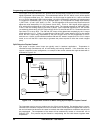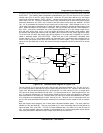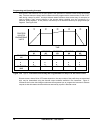
Programming and Operating Concepts
Video Recorder – User Manual 70
Set Point Profile Implementation
By definition, set point profiles are essentially user specified plots of process values against time. These
plots are characterized by “segments” which are a series of intervals of varying time lengths that divide
the plots into several segments. Within each segment, process values are typically drawn as straight
lines that ramp up or down or stay constant at predetermined levels. An example of a simple five-
segment set point profile is shown in Figure 3-23. Set point profiles with up to 63 segments can be
specified using the instrument. Note that when a segment depicts the process value as sloping up or
down, it is referred to as a “ramp.” The term “soak” is used to describe a segment when the process
value is made to stay constant. In Figure 3-23, segments 1, 3, and 5 are ramps while segments 2 and 4
are soaks.
PROCESS
VALUE IN
ENGINEERING
UNITS
&'()*
TIME
Figure 3-23 Example Set Point Profile
To force a process value to vary linearly with time at various rates within successive time intervals is the
job of a set point profiler, another class of function blocks available within the instrument. Be advised
that use of set point profilers is typically observed in thermal or heat treat applications. For example,
being able to vary temperature in accordance with a set point profile is vital in the tempering of metal or
ceramic parts.
Refer to the application of Figure 3-11 discussed at the beginning of this section. This application dealt
with controlling a furnace zone’s temperature by means of a 4 to 20 mA gas valve actuator. If the
furnace zone temperature were to be manipulated so that it followed the ramps and soaks of a set point
profile, the first step would be to implement the function block diagram established in Figure 3-16In
general, the control configuration that holds a process value to a local set point, must be programmed
and on line before allowing the process value to be characterized by a profile. With regard to the
application at hand, a set point profiler function block programmed with a user defined set point profile
may be brought into the configuration once the furnace zone’s basic temperature control loop is
operational. Note that the output of the profiler function block will essentially be the set point profile.
From the cascade control strategy’s explanation, recall that all control loop function blocks within the
instrument have a Setpoint #2 parameter that may be used as a remote set point input for connecting to
the profiler’s output.
LP1 in the function block diagram of Figure 3-16 will make use of SP2’s remote set point functionality so
that a set point profiler’s time varying set point may be applied to it. Refer to Figure 3-24.


















